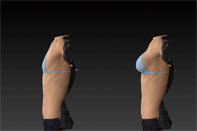If you’re fit, physically active, and have recently undergone implant surgery, it can be really frustrating to have to wait a few months before you start working out again. As great as the temptation to go back to your regular workout routine is, it’s generally recommended that you allow ample time for your body to heal.
Taking time off from working out will allow your body to heal faster from the breast implant surgery. Now is not the time for “no pain, no gain” as your body needs all its energy to heal up. Waiting until your body is fully healed will help speed the recovery time as well as avoid any potential medical complications.
Most doctors generally recommend at least 2-3 months to fully recover and go back to your normal workout routine. At the bare minimum, they recommend you wait at least 2 weeks until you start light cardio work on a stationary bike. It can take up to 2 months before you can aggressively start lifting weights or doing CrossFit again.
Immediately after the surgery
After the surgery has been successfully completed, the doctors will move you to a recovery area. You’re going to be kept here for anywhere from 1-2 hours, depending on how long it takes you to come out of general anesthesia. Sometimes the nurses might give you something to drink like a glass of juice or something small to each like a cracker.
Depending on your tolerance to pain medications, you might feel groggy for a few hours after you leave the surgery center. You might also be in some pain afterwards. Doctors have said that women who have given birth to children prior are generally more tolerant to pain than women who have not.
The first 1-3 days after your surgery can be written off as ‘staying bed and healing’ days. A few hours after you come out of the general anesthesia, you’re probably going to start feeling the first twinges of pain in your chest area. At this point in time you’re most likely going to reach for the bottle of prescription pain killers the doctor gave you. You can kiss the next 6-7 hours goodbye as the powerful pain meds put you to sleep.
What to expect from the recovery
The basic recovery process can take anywhere from 1-2 weeks. Full and complete recovery can take anywhere from 1-3 months. It all depends on how quickly your body heals. The healing process can be prolonged if you prematurely start to exercise prior to being given the “ok” by your doctor.
For the first few weeks, you may also feel like there is a massive weight on your chest and extreme soreness in your pectoral muscles. Daily activities such as walking, standing up, getting up from a chair, washing your hair, reaching to grab something can all lead to extreme pain as you are using your pectoral muscles in some way or form.
You might also have tubes or drains coming out of your breasts. Medical bras, straps and intense pain sum up what most women go through in the first week or two after the procedure.
Bottom line: it takes weeks to heal up from implant surgery.
24 Hour Rapid Recovery by Dr. Adams
Or so it did until Dr. Adams came out with his “24 Hour Rapid Recovery” implant procedure. In this procedure, 95% of patients are up and proverbially running in as little as 24 hours. Dr. Adams has refined several innovative techniques that minimize tissue damage and as such there is very little post-operative pain. One of Dr. Adams recent patients created a home movie about her experience and she was literally back in the gym working out just two weeks after the surgery.
Dr. Adams has over 15 years of experience and is a National Expert in breast augmentation. He is published in various medical journals and has created educational curriculum for aspiring breast implant surgeons to learn how to do implant surgery better.
When it comes to breast implants, you get what you pay for. If you visit a cut-rate implant doctor, you’re going to get cut-rate work which could lead to dissatisfaction on your part and potentially another implant operation to fix what you don’t like. A good portion of the patients that Dr. Adams sees were not satisfied with the work done by their previous surgeon.
One of the biggest contributing factors to patient satisfaction is undergoing a proper consultation prior to surgery. Dr. Adams listens to the wants and needs of the patient and then advises them on the best route forward that would lead to their satisfaction. Matching the implant to the tissue quality and dimensions of each patient contributes significantly to their overall satisfaction with the end results.
Patient satisfaction
There have been many peer-reviewed medical studies which show the reoperation rate for women who have breast implants hovers right around 15-23%. That is extremely high and due in part to the plethora of ‘coupon code’ surgeons out there who are only in it for the money. Their mission is to get women on the operating table and a check in their bank accounts. They sometimes fail to warn their patients about getting the wrong implant size. This leads to a high rate of dissatisfaction amongst a good portion of their patients. Dr. Adams published re-operation rate is only 3%, which is a mere fraction of the overall average.
Patients who have undergone Dr. Adams 24 hour Rapid Recovery process are amazed at how great they feel just hours after the surgery. No prescription pain killers (except for over-the-counter Motrin) are required and that means you won’t be stuck in bed or on the couch in complete pain, feeling like a piece of Jell-O from the pain meds.
Do you still have questions about implant surgery and how it could affect your daily work-out routine? Give us a call or contact us to learn more about working out and Dr. Adams 24 Hour Rapid Recovery process.















